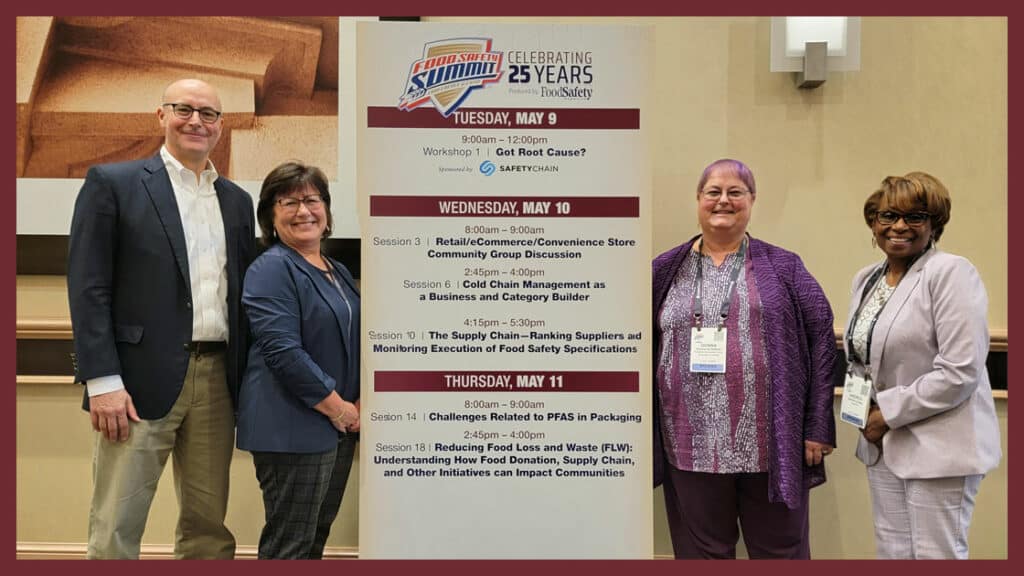Our simple session expanded to strategic concepts such as enterprise-wide governance, food safety issues within a broader Lean Six Sigma program and reviewing other industries. I appreciate our panelists taking the time to participate: Andrea Anase (PepsiCo), Donna Schaffner (Rutgers), Deb Kane (J&J Snack Foods) and Vera Petrova-Dickenson (Innova-Q).
I’m honored to have been able to convene, moderate, and present for this Food Safety Summit session on “The Supply Chain – Ranking Suppliers and Monitoring Execution of Food Safety Specifications.”
Session Overview
From the session description: “Supply chains have been under unprecedented stress. From food safety incidents, COVID disruptions, Ukraine-Russia impacts, and now inflation, there has been increased awareness and scrutiny of supply chain management. This session will review best practices for evaluating supply chain disruption vulnerability and the role of supply chain quality assurance and food safety certification.”
My co-panelists included:
- Andrea Anase, Senior Manager, Global Food Safety, PepsiCo
- Donna Schaffner, Associate Director of the Food Innovation Center, Rutgers University
- Deb Kane, VP of Food Safety and Quality, J&J Snack Foods Corporation
- Vera Petrova-Dickenson, Principal, Innova-Q
While driving home from the Food Safety Summit last week and then while writing this blog, I remembered how valuable and important it is to get together for the presentations and the additional discussions — meeting with the panel team to brainstorm ideas before our session was very invigorating. With the audience, we gained further insight during the session. I think the most significant insights came from the sidebar discussions between presentations and at social events.
I am so grateful to Andrea, Donna, Deb, and Vera for making the time and effort to attend and present.
Key Points
Three main ideas framed the session:
- Integrated Supply Chain Management (ISCM): Each part of the supply chain is essential, and individual actions such as food safety management are crucial, but to keep the product flowing, there needs to be an end-to-end and comprehensive perspective. That said, success is achieved when focusing on the supply network, not just a single supplier.
- Food Safety Governance: For incredibly important topics such as food safety, developing expertise and assigning resources to the specific function is important. That said, if there is too much of a siloed approach, then there is sometimes a lack of buy-in from other functions or gaps in oversight. (This was a specific research topic by Vera Petrova-Dickenson.)
- Managing New Problems (E.g., Food Fraud Prevention or novel food safety issues): When there are new problems, such as a new manufacturing process or a new root cause, such as food fraud, there is a standard way to classify and address the issue. To start, it is critical to frame the problem in a larger context – for example, beginning within the food safety management system. This could be within the Global Food Safety Initiative (GFSI) type compliance for food safety. Then, it is helpful to have a common starting point, such as simple ‘yes or no’ question surveys. After the problem is framed, then the responses can be strategically developed.
Insights
For me, there were three key insights:
- Enterprise-wide governance: When there is a new emergency, it is common to respond by diving deep into an organization to address that very specific problem. For food safety, that might be a response to the unique details of one incident or recall. For food fraud prevention, that may be focusing only on one type of raw material from one location. This is optimal for dealing with that one problem but not for dealing with all related issues. To coordinate and prioritize risk management across many job functions, there really needs to be an over-arching, enterprise-wide assigned entity. For some food companies, there is a Chief Food Safety Officer who is really in the “C-suite” reporting to the CFO or COO. Food fraud should also be governed at that level, though possibly not as a separate position, but under the CFSO.
- Frame food safety in business terms such as Lean Six Sigma: It might seem counterintuitive or counterproductive to have food safety subservient to another concept, but there might be a way to actually increase the visibility and importance. We place food safety management under quality management or quality assurance, but other concepts may help enterprise-wide priority setting. For example, there may be a way to more clearly compare very different problems, such as if the food safety incident is framed as a type of supply chain disruption within a Lean Six Sigma program. The public health impact is, of course, the most important component, but there may be other ways to assess the problem in a more common context.
- Risk management lessons learned from other industries: Vera Petrova-Dickenson raised the question about comparing how food safety is managed in relation to the quality or risk management in different sectors such as auto, aerospace, consumer electronics, or industrial chemicals. Other industries may also be able to learn from the food industry.
Takeaway Points
- Food safety – and food fraud – management is evolving. The governance and decision-making structure are critical and could innovate to be more efficient.
- Food safety management needs to continue to have a balance between one-on-one supplier-customer activities but, with the over-arching integrated supply chain approach.
- Attending industry events is valuable (yes, duh, but more than that). Traveling to conferences takes more effort than staying in home offices, but the energy gained and insight developed were outstanding.

